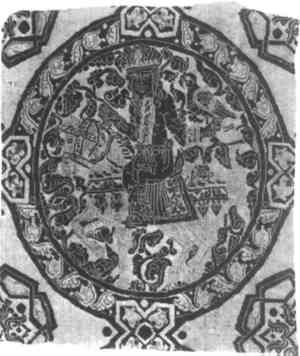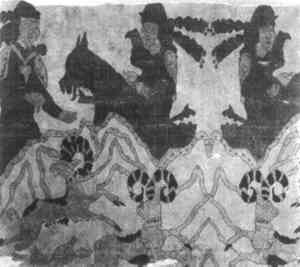THE DETECTION OF METALLIC MORDANTS BY ENERGY DISPERSIVE X-RAY SPECTROMETRYR.J. Koestler, N. Indictor, & R. Sheryll
ABSTRACT—Thirteen silk fibers from seven different historical silk textiles were subjected to EDS analysis. The major metallic elements detected were aluminum, iron, calcium, silicon and potassium. No evidence for copper, chromium, tin or zinc was found. These results were compared to analyses of known mordanted silk samples. 1 INTRODUCTIONTHE SCIENTIFIC AUTHENTICATION OF HISTORICAL material is a difficult and controversial process. It is impossible strictly speaking to prove the authenticity of any object based on technical information, although it is sometimes possible to find the chronological age of the material employed. The manufacture of the object can rarely be dated with absolute certainty or precision based solely on scientific observations, and the dating of both the material and the manufacture can never be proved since it is possible to imagine modern craftsmen with a knowledge of ancient technology. The darker side of this pursuit may have much clearer and straight-forward results: it is sometimes possible to prove that an object or material is other than it purports to be by the objective dating of the material or by discovery of a manufacturing procedure inconsistent with the purported age of the object. Sometimes documentation can date an object and place it unambiguously in its historical context. Most frequently it is necessary to come to a conclusion concerning authenticity by means of considerations from more than one discipline—stylistic analysis, historical documentation, elemental analysis, visual and microscopic examination—which, taken together, present a picture consistent with a particular time, place, workshop or worker. Reading all these cues to form a coherent and consistent picture is gradually becoming more and more difficult owing to the high level of specialization needed to master the several disciplines involved. The collaboration of scientists and art historians becomes especially necessary in problem areas where contradictory evidence and opinions give an ambiguous assessment. Such a problem area is found in a group of silk textiles usually referred to as “Buyid Silks” (see Figs. 1–4). These silks are said to have been found in 1925, during excavations in Bibi Shahr Banu, near Rayy, Persia. Some of these silks received extensive technical scrutiny with respect to pattern, calligraphy, use, weaving techniques and dye analysis in 1973–74.1,2 The absence of decisive pronouncements concerning the chemical analyses of the textiles was most unfortunate; analytical methods employed and uncertainties reduced the value of objective statements concerning authenticity. Dyes were analysed by thin layer chromatography and were matched with chromatograms of known dyes. The present day state of the art which would utilize high performance liquid chromatography (HPLC) or gas chromatography-mass spectrometry (GC-MS) combinations should give identifications of the dyes (permitting smaller samples than earlier studies) with the likelihood of a more complete structure identification.3 Carbon-14 dating gave results for the textiles sampled which proved to be uninterpretable, corresponding to neither the 20th century A.D. nor to the 11/12th century A.D. The present day state of the art for C-14 analysis permits analysis of much
In recent studies in our laboratory the feasibility of detecting mordants on textiles has been explored by exposure of small samples to the high energy electron beam of a scanning electron electron microscope (SEM) with subsequent detection by energy dispersive x-ray spectrometry (EDS). Modern mordanted samples of silk, cotton, and wool were analysed successfully for aluminum, iron, copper, tin, and chromium.5 In Part I of this study cochineal dyed wool samples mordanted with the same mordants were also successfully analyzed for these elements. In this part, results are reported for a small number of “Buyid Silks” now in the Cleveland Museum of Art. Textiles sampled are pictured in Fig. 1. Each sample was taken from uniformly colored threads of the textiles and were analysed by EDS for the presence of metallic elements. The metallic elements found in the samples were calcium, iron, aluminum, silicon and potassium. No evidence of chromium, copper, tin, or zinc was found. These results are compared to results obtained for modern textiles.5 2 EXPERIMENTALSAMPLES WERE TAKEN FROM SEVEN textile fragments. Individual fibers were separated according to color. A single fiber of each color was carbon coated with approximately 15 nm of spectroscopically pure carbon in an Edwards vacuum evaporator and viewed in an Amray 1600T scanning electron microscope with a Kevex EDS spectrometry system. The collection conditions were: 20 kV; 200 seconds; area scanned was full fiber width at about 1–2000 magnifications. The samples were analysed as received, without washing or cleaning. Samples appeared to be clean and unsoiled. 3 RESULTS AND DISCUSSIONTABLE ILISTS THE TEXTILES AND ACQUISITION numbers of the silk textiles studied. The color of the fiber taken from each textile is also given and the elements found are shown in descending order of abundance. Each sample showed the presence of sulfur as would be expected from silk.6 The level of sulfur appears to be slightly lower than that found in modern undyed mordanted samples examined in earlier studies5 with the exception of B-5-a and B-5-b. It is possible that this is the effect of aging (loss of sulfur) or the effect of dyeing or mordanting. The observed weight percent of any element will obviously decline in the presence of added matter. The weight percent in all samples reflects only weight percent of elements above the atomic weight of fluorine and not the weight present in the sample. The brown and gray fibers appeared to have significantly less sulfur than the other colored fibers. Lowered sulfur content of proteinaceous fibers has often been associated with aging.7Table I also indicates the presence, at least in trace amounts, of aluminum and iron in all fibers except B-5-b, undyed. Table I Historical Silks: Results of EDS Scans The judgment as to whether the aluminum or iron has been used as a mordant or was present from some other source was tentatively based on the ratio of metallic element to sulfur rather than the absolute value of the element (Table II). A similar procedure was used sucessfully for mordanted, dyed modern wool samples on which sulfur was also used as an internal standard (see Part I). A “yes” entry was made for aluminum when the ratio of aluminum to sulfur was ca. 2:1; a “?” was entered, possibly present, when the ratio of aluminum to sulfur was ca. 1:1; “(-)”, probably absent was Table II Presence of Metallic Mordant on Historical Silks The foregoing technical information illustrates some points made in the introduction. Authentication of the materials under discussion is not possible based on the data obtained. However none of the elements detected suggests a technology in the We plan to enlarge our study of mordants on historical textiles; we are also planning a study of metallic yarns and weighted-silk fabrics. 4 CONCLUSIONS
REFERENCESBulletin de Liaison du Centre International D'Etude des Textiles Anciens (Lyons). Nos. 37–40, 1973, 1974. Contributions by M. Lemberg; G. Vial; J.H. Hoffenck-De Graff; and D.G. Shepherd. Irene Emery Roundtable on Museum Textiles, 1974, Proceedings Archaeological Textiles. Ed.P.L.Fiske; D.G.Shepherd, “The Archaeology of the Buyid Textiles,” 175–190; N.Kajitani, “The Physical Characteristics of Silk Generally Classified as ‘Buyid’(10–13th Century A.D., Persia), 191–204. Washington, D.C., 1974. Whiting, M.C., “Recent Advances in the Detection and Identification of Red and Yellow Dyes,” Dyes on Historical and Archaeological Textiles. 1st Mtg. York Arch. Trust (August 1982), p.2; DeWitte, E. and Terfve, A. “The Use of a PY-GC-MS Technique for the Analysis of Synthetic Resins,” Science and Technology in the Service of Conservators 1982 IIC Preprints, pp. 16–18. Washington, D.C., 1982. Hall, E.T., R E.M.Hedges, J.O.Wand and N.R.White, “Radioactive Dating by Mass Spectrometry: Progress at Oxford,” Revue d'Archeometrie4, 51–58, (1980); Hewson, A.D., “Interpretation and Exploitation of an Interlaboratory Comparison of Radiocarbon Measurements,” Revue d'Archaeometrie, 4, 53–72 (1980); Stenhouse, M.J. and M.S.Baxter, “An Assessment of the Current Role of Conventional Radiocarbon Dating Laboratories in Archeology,” Revue d'Archaeometrie, 4, 45–56 (1980). Koestler, R.J., R.Sheryll and N.Indictor, “Identification of Dyeing Mordants and Related Substances on Textile Fibers: A Preliminary Study Using Energy Dispersive X-Ray Spectrometry,” Studies in Conservation (in press). Stevens, M.P.Polymer Chemistry An Introduction. Addison-Wesley Reading, MA, 1975, p.417; data from Handbook of Commercial Polymers, The Chemical Rubber Co., Cleveland, OH, 1971. Baer, N.S., M.Delacorte and N.Indictor, “Chemical Investigations on Pre-Columbian Archaeological Textile Specimens” in Preservation of Paper and Textiles of Historic and Artistic Value, Adv. in Chem. Series 164, Wash., D.C., 1977, pp.261–271. Masschelein-Kleiner, L and L.R.J.Maes, “Ancient Dyeing Techniques in Eastern Mediterranean Regions,” International Council of Museums Comm. for Conservation, 5th Council Mtg., Zagreb, 1978, 78/9/83. ACKNOWLEDGEMENTSWe would like to thank the J.H. Wade Fund of The Cleveland Museum of Art for permission to publish the photographs.
 Section Index Section Index |



